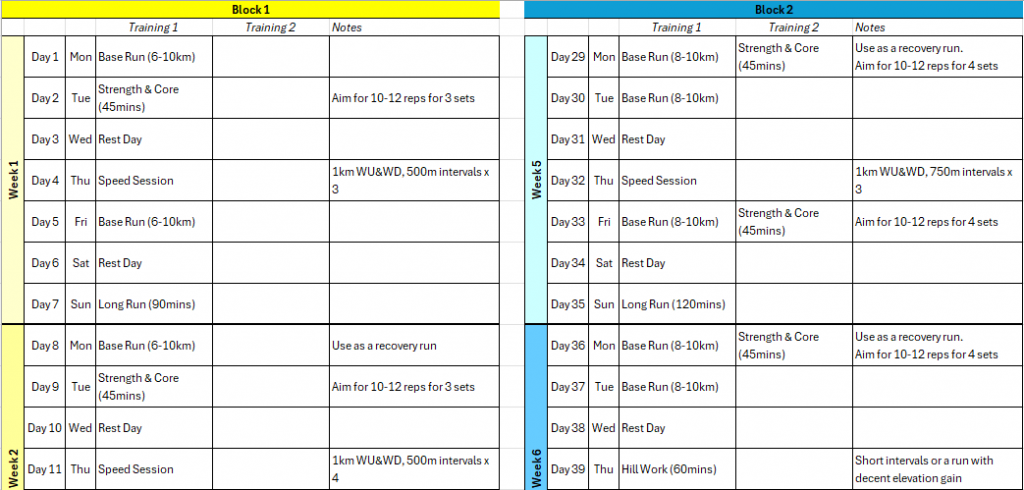
So, if you’re reading this, then you’re probably thinking about dipping your toe into the world of ultra-running and signing up for your first 50 miler and now need a 12 Week Training Plan. Or maybe you’ve already taken the plunge, and now you’re wondering how in the world you’re going to actually make it across that finish line without crawling or collapsing in a heap and questioning all your life choices.
Let’s be real, 50 miles sounds like a cruel joke when you say it out loud, right? But here’s the secret: when you break it down into manageable chunks, it’s actually less “I’m gonna die” and more “Okay, I’ve got this.” With a solid fitness base and a mindset that refuses to back down (even when your legs are screaming at you to stop), crossing that finish line becomes not just possible, but downright achievable.
First things first: congratulations on signing up for what might just be the most epic (and slightly masochistic) adventure of your life! Now, before you lace up those running shoes and hit the trails, let’s talk training. Remember, Rome wasn’t built in a day, and neither is a 50-mile ultra-runner. Start slow, and by slow, I mean SLOW. You’re not trying to win a marathon here. Focus on building endurance, and don’t be afraid to walk. Yes, walk! Your future self will thank you when you’re not shuffling around like a zombie the day after your first long run.

I’m not a professional running coach, but let’s just say I’ve completed enough ultras and logged enough miles to be considered an honorary one. Through countless training runs, I’ve learned what works, what doesn’t, and what you definitely shouldn’t try at 6am. on an empty stomach. Here I pass along what has worked for me in the past, so you don’t have to reinvent the wheel. Hopefully, this’ll save you some time and make your training journey a little smoother and maybe even faster.
Aspiring 50-mile runners should begin their training with a solid running base, feeling comfortable running long runs over 20 miles, and have experienced running 35–40-mile weeks previously while remaining injury free.
You should also be prepared to run upwards of 50-60 miles per week across 5-6 days of workouts with some double training days thrown in. Trust me, it’s definitely a time commitment, so I recommend that you really take an honest look at your day-to-day life, and make sure that this volume of training will fit into your week and be prepared for sacrifice.


This basic plan will be split into 3 blocks with each block consisting of 4 weeks, with the final week of the block being a cutback week where you will still train, but with less intensity and more focus on recovery and resetting the body and mind. Stretching is recommended every day, preferably pre and post run. But as a minimum, suggested every day on waking up.
Now that I’ve laid the groundwork for your training block, I’ll explain the specific workouts that will form the backbone of your preparation. These workouts are designed to build your endurance, strength, and mental fortitude, ensuring you are well-equipped to tackle the challenge of a 50-mile race. Each type of workout serves a unique purpose, and together they create a well-rounded training plan that will help you progress safely and effectively.
Base Building Run
The concept of a base building run revolves around running at an easy, aerobic pace, often described as a “conversational pace.” This means running slowly enough that you can comfortably hold a conversation with a running partner without gasping for breath. Base building runs are fundamental in laying a strong endurance foundation, as they help your body adapt to the demands of longer mileage and prepare you for more intense workouts down the line. By keeping the intensity low, these runs also minimize the risk of injury and burnout, ensuring that your body can handle the increased volume of training required for ultramarathons.
Base building runs are crucial for several reasons. Primarily, they enhance your aerobic capacity, allowing your body to become more efficient at using oxygen during prolonged exercise. This process also encourages fat oxidization, meaning your body becomes better at utilizing stored fat as an energy source, which is vital for endurance events. By engaging in consistent base building runs, you develop the stamina and resilience needed to tackle the rigors of ultra-running, making the gruelling miles not just manageable but achievable.
Frequency: 70-80% of total training days.



Speed or Hill Training
Speed work and hill training are integral components of a robust running training plan. Speed work involves running at a faster pace over short distances with recovery periods between each sprint. Examples are Intervals, Tempo run, Threshold run and Fartlek training. This type of training enhances your running economy, improves your lactate threshold, and increases your overall speed and endurance. By pushing your anaerobic limits, you teach your body to handle lactic acid more efficiently, which is crucial during the latter stages of a long race. Speed work also aids in the development of fast-twitch muscle fibres, which are essential for quick and explosive movements, enhancing your overall performance.
Hill training, on the other hand, focuses on building strength and power in your legs by running uphill and practicing controlled descents. This type of workout simulates the challenging elevations you might encounter during an ultramarathon. By incorporating hills into your training, you not only strengthen your muscles, tendons, and ligaments but also improve your cardiovascular and respiratory systems. Hill workouts force your body to work harder, thus increasing your climbing efficiency and endurance. Also, the descents help in learning to manage speed and technique, reducing the risk of injury during actual race conditions.
Frequency: 10-20% of total training days.


Long Run
Long runs are the cornerstone of any comprehensive ultramarathon training plan, providing both physical and mental conditioning necessary for long-distance events. These runs, which are longer in duration than regular training runs, are typically performed at an easy, sustainable pace, allowing you to build endurance gradually. The primary purpose of long runs is to accustom the body to the prolonged exertion that characterises an ultramarathon. By steadily increasing the distance, runners can enhance their aerobic capacity, improve their metabolic efficiency, and adapt to the physical demands of running for extended periods. This adaptation process is crucial for developing the stamina required to complete ultra distances without succumbing to fatigue prematurely.
Beyond the physical benefits, long runs also serve as an invaluable opportunity for you to fine-tune your race-day strategy. They act as a ‘dress rehearsal,’ enabling you to experiment with various aspects of your race preparation, such as nutrition, hydration, gear, and pacing. This practical experience is essential for identifying and resolving any issues before race day, ensuring that you are as prepared and confident as possible.
Frequency: 1 per week (2 later in the plan)

Strength Training
Strength training for runners is a crucial component of an effective training regimen, as it enhances overall performance and minimises the risk of injury. This is something I learned the hard way, cutting it out altogether at one point and only focusing on the mileage I covered, I ended up getting injured and not being able to run for 6 months. Often overlooked in traditional running programs, strength training focuses on building the muscles and connective tissues that support the repetitive impact of running. By incorporating exercises that target the major muscle groups involved in running—such as the glutes, hamstrings, quadriceps, and core, you can improve your stability, power, and efficiency, leading to better performance and reduced fatigue during long-distance events.
The importance of strength training for runners cannot be overstated. Running alone can create muscular imbalances, as certain muscles become overused while others remain underdeveloped. This disparity can lead to poor running mechanics, increased stress on joints, and a higher likelihood of injuries such as strains, sprains, and stress fractures. Strength training helps correct these imbalances by reinforcing underutilised muscles and promoting better alignment and posture. Additionally, a well-rounded strength training program enhances bone density, which is vital for preventing bone-related injuries, particularly in high-mileage runners.
Some excellent strength exercises for runners include squats, lunges, deadlifts, and planks. Squats and lunges are fundamental lower-body exercises that target the glutes, hamstrings, and quadriceps, crucial for power generation and stability during running. Deadlifts, which focus on the posterior chain, are essential for building strength in the lower back, glutes, and hamstrings, thereby improving running form and efficiency. Planks and other core exercises, such as Russian twists and leg raises, help develop a strong core that supports the spine and enhances balance and posture during running. Incorporating these exercises into your regular training routine (even just once per week) will not only boost running performance but also contribute to long-term health and injury prevention.
Frequency: 1-2 per week

Rest Days
Rest days are another essential aspect of your training schedule, providing a critical balance between exertion and recovery. Contrary to the belief that constant running leads to faster improvement, it is during rest periods that the body repairs itself from the micro-damages sustained during workouts and strengthens the muscles and connective tissues. These recovery phases are vital for adapting to the increased physical demands of training, preventing overuse injuries, and maintaining overall health. Without adequate rest, you risk training-related injuries such as stress fractures, muscle strains, and chronic fatigue, which can significantly hinder progress. Therefore, incorporating regular rest days into your training plan not only optimises performance but also ensures long-term sustainability in the sport.
Frequency: 1-2 per week
Active Recovery
Active recovery will mainly be applicable during cutback weeks or easy weeks, when the body needs to recuperate from intense training sessions. Unlike complete rest days, active recovery involves engaging in low-intensity activities that promote blood circulation, aid in muscle recovery, and enhance overall cardiovascular endurance without placing additional strain on the muscles and joints. Activities such as swimming, cycling, hiking, yoga, and using the elliptical are excellent options for active recovery days. These light exercises help flush out toxins, reduce muscle stiffness, and speed up the recovery process, allowing you to maintain your fitness levels while giving your body a break from the repetitive impact of running.

Feel free to download my excel version of the free 12 week plan. And contact me with any questions.
And there you have it! – A basic training plan and guide to completing your first ultramarathon! Remember, the road to achieving your impossible is paved with squats, lunges, and the occasional plank-induced pain. So, lace up, embrace the burn, and get comfortable being uncomfortable but don’t forget to enjoy the journey. After all, as you surpass your limits, you’re not just collecting miles, you’re gathering stories, savouring achievements, and making memories. Go get it!


Leave a Reply